SWELL – Warrenpoint WwTW (2021)
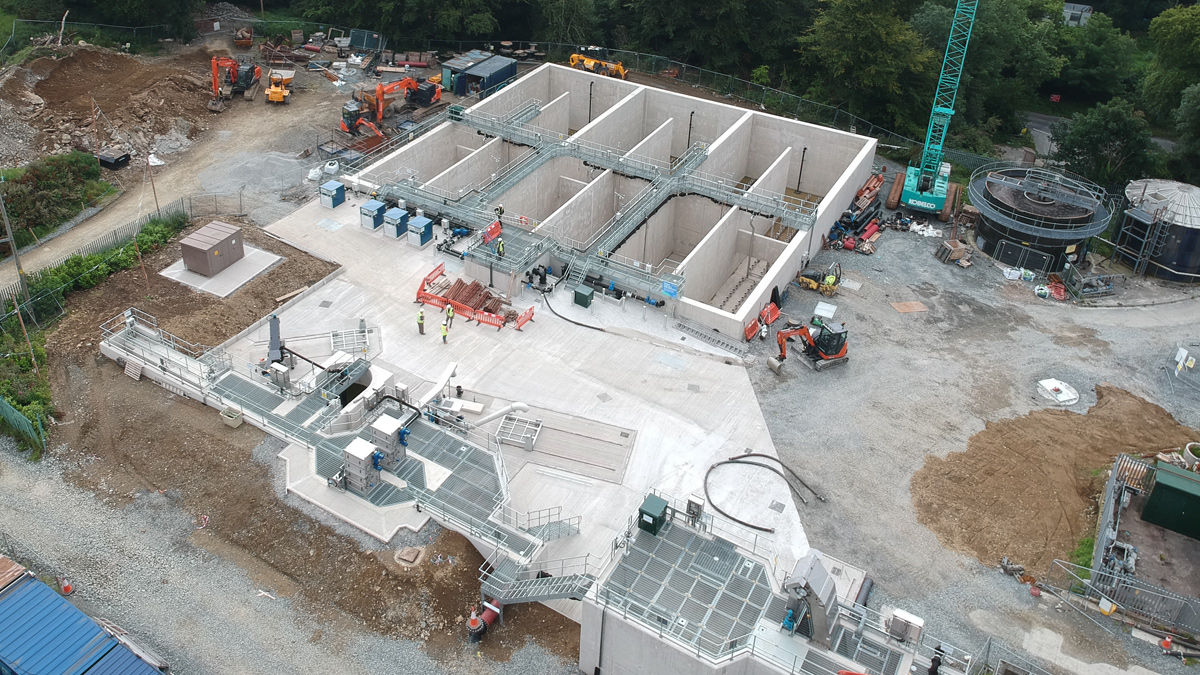
Warrenpoint WwTW – ASP, inlet structure and attenuation tank - Courtesy of NI Water SWELL
Warrenpoint is a small town in County Down, situated on the northern shore of Carlingford Lough, approximately 7 miles south-east of Newry. The shared water of Carlingford Lough marks the border between Northern Ireland and Ireland. Due to its scenic beauty and coastal location, Warrenpoint is popular with day trippers and the town can experience an influx of visitors during the summer months. Warrenpoint WwTW is located to the western edge of the town approximately 250m from the lough shoreline. Constructed in 1976, Warrenpoint WwTW serves Warrenpoint town and the neighbouring villages of Rostrevor and Burren. The existing plant comprises an inlet works (6mm fine screening and grit removal), four activated sludge basins (treatment process using aeration) and two final settlement tanks. Stormwater storage, sludge treatment and a sludge storage tank are also present to support the process. The existing works was designed for a population equivalent of 16,195, with treated effluent being discharged via a 300m long, 450mm diameter outfall pipe directly into Carlingford Lough.
Need for upgrade
Investigations showed that Warrenpoint WwTW was receiving flows from a population equivalent of 16,259. This meant that the works was operating beyond its intended design capacity and operational problems resulted from excessive flows being pumped to the inlet works. This problem was exacerbated by network infiltration/tidal ingress and inadequate flow balancing at the WwTW, resulting in un-attenuated flows, premature use of storm tanks in dry weather conditions, and loss of untreated wastewater loading to Carlingford Lough. This factor was considered to be a significant potential source of wastewater pollution to Carlingford Lough, making Warrenpoint WwTW a key asset for a £6m upgrade under the EU-funded SWELL (Shared Waters Enhancement & Loughs Legacy) project.
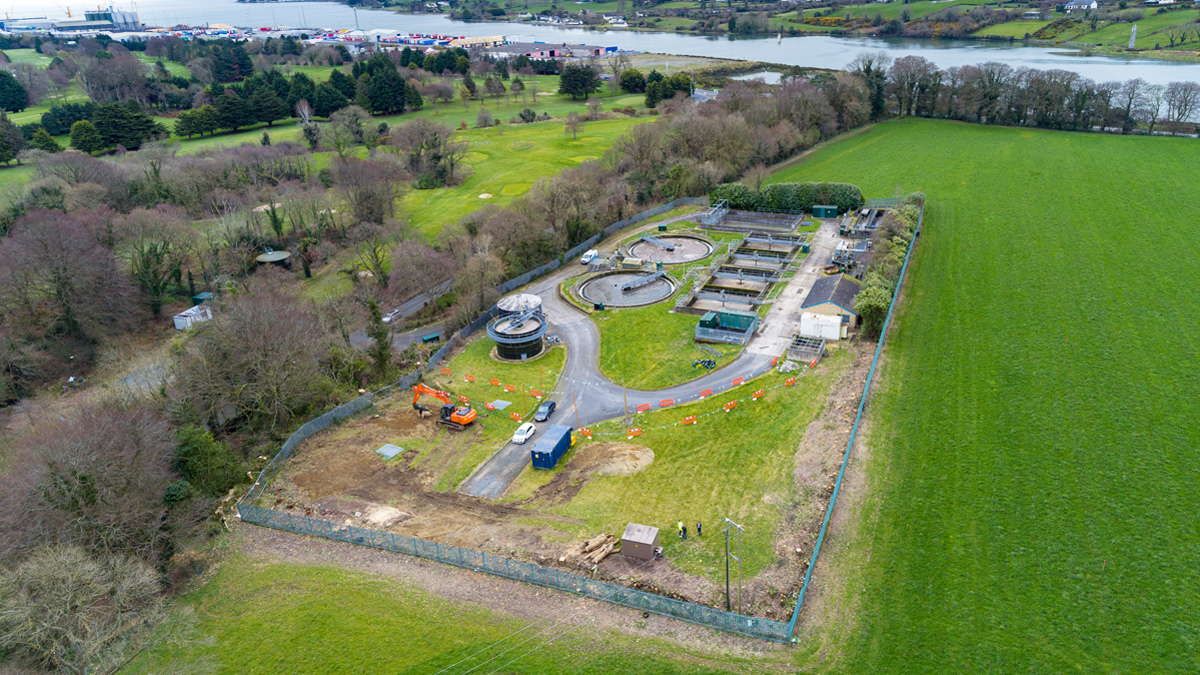
Warrenpoint WwTW (April 2019) before SWELL upgrade – Courtesy of NI Water SWELL
What the upgrade involved
The SWELL project concentrated efforts on alleviating immediate pollution problems, taking into account the potential need for a more stringent future treatment solution so as to make best use of the work and expenditure.
The upgrade at Warrenpoint WwTW was planned in two stages: The first phase of work, carried out under the SWELL project, was to address overloading and potential loss of wastewater loading to improve water quality within Carlingford Lough. The second phase, which would follow on from the SWELL improvements, will ensure compliance with a more stringent discharge consent in accordance with NI Environment Agency requirements.
Project team
As main contractor, GEDA Construction had overall responsibility to deliver the project on time and within budget, which they succeeded in doing by working in collaboration with NI Water, project managers McAdam, key suppliers and sub-contractors to identify and prepare for key milestones for the project. Atkins provided civil, structural and geotechnical design services, including the initial enabling and investigatory works through to optioneering/outline design and detailed design for construction. Water Solutions Ireland (WSI) carried out a full turnkey MEICA, process design and build solution for the SWELL upgrade.
Warrenpoint WwTW: Supply chain – key participants
- Client: NI Water
- Civil contractor: GEDA Construction
- Project managers: McAdam
- MEICA contractor: Water Solutions Ireland
- Civil, structural and geotechnical design: Atkins
- Electrical design: KGOR Design Consultancy
- PLC software: Ashdale Engineering Ltd
- Storm screens: Eliquo Hydrok Ltd
- Washpress units: Huber Technology
- Screen, grit plant & classifier: Jacopa Ltd
- 6mm Screens: M and N Electrical and Mechanical Services
- Blowers: Aerzen Machines
- MCC: Greenville IDC
- Pumps, mixers, diffusers, ammonia monitors: Xylem Water Solutions
- Instrumentation: Park Electrical Systems
- FFT Flume: Siris Environmental Ltd
- Davits: RJ Smyth
- Penstocks, valves & actuators: Flow Technology Services
- Tipping buckets: CSO Group Ltd
- Launder, 10mm bar screen, skip rails & trolleys: Graham Steelworks & Engineering (GSE)
- Airflow meters, air switches: IFM Electronics
- Lifting Gantry: Columbus McKinnon Co Ltd
- Standpipe: Kaver Laminates
- Hoses: Reelcare
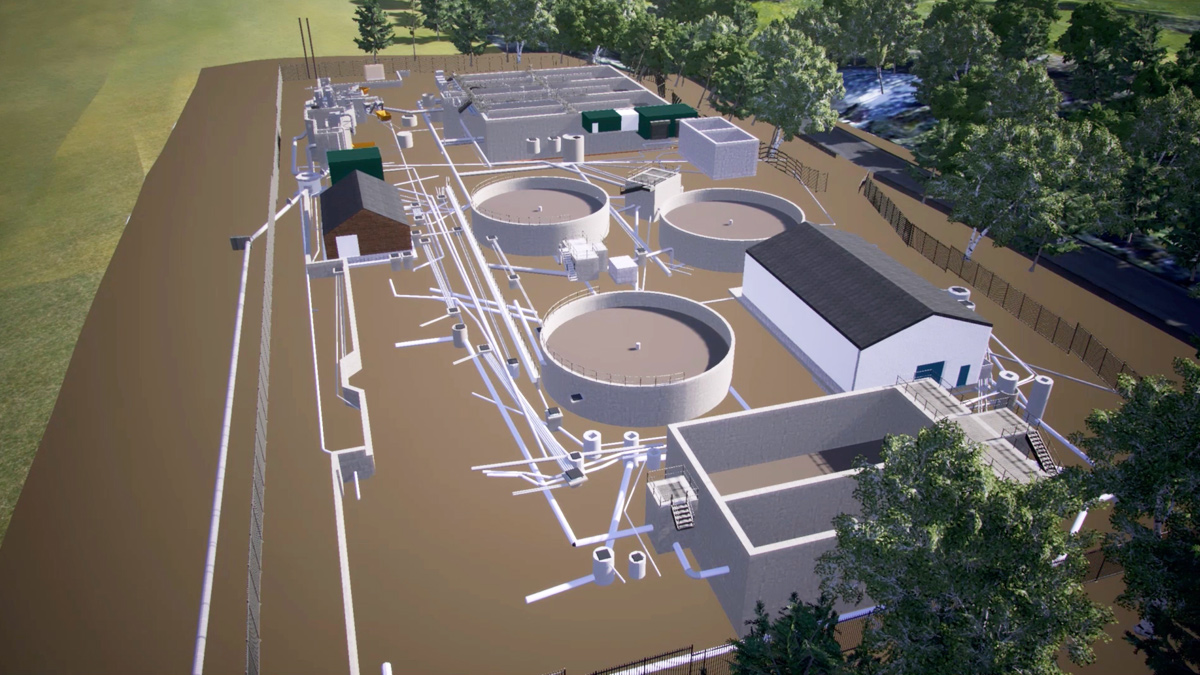
Warrenpoint 3D model – Courtesy of Atkins
Challenges
The main challenges faced during the delivery of the Warrenpoint Phase 1 scheme were a mixture of site-specific constraints and challenges experienced by the construction industry as a whole. Through a collaborative approach, the project team worked continually to achieve the project’s objectives. Some of the challenges were as follows:
Warrenpoint WwTW had a complex arrangement of interconnecting pipes and services, and managing the interfaces between existing and new infrastructure was a key element of the design. Atkins adopted BIM Level 2 protocols from the outset and developed integrated 3D models for existing and proposed works which allowed designers, contractor and client teams to collaborate from the optioneering phase through to construction and commissioning.
One of the key challenges involved the pouring of 700m3 of concrete for the aeration tank base. This involved extensive liaison with DFI Roads to close the hard shoulder of the A2 carriageway. The pour commenced at 6pm and was completed at 6am to avoid traffic congestion around the major link city, Newry.
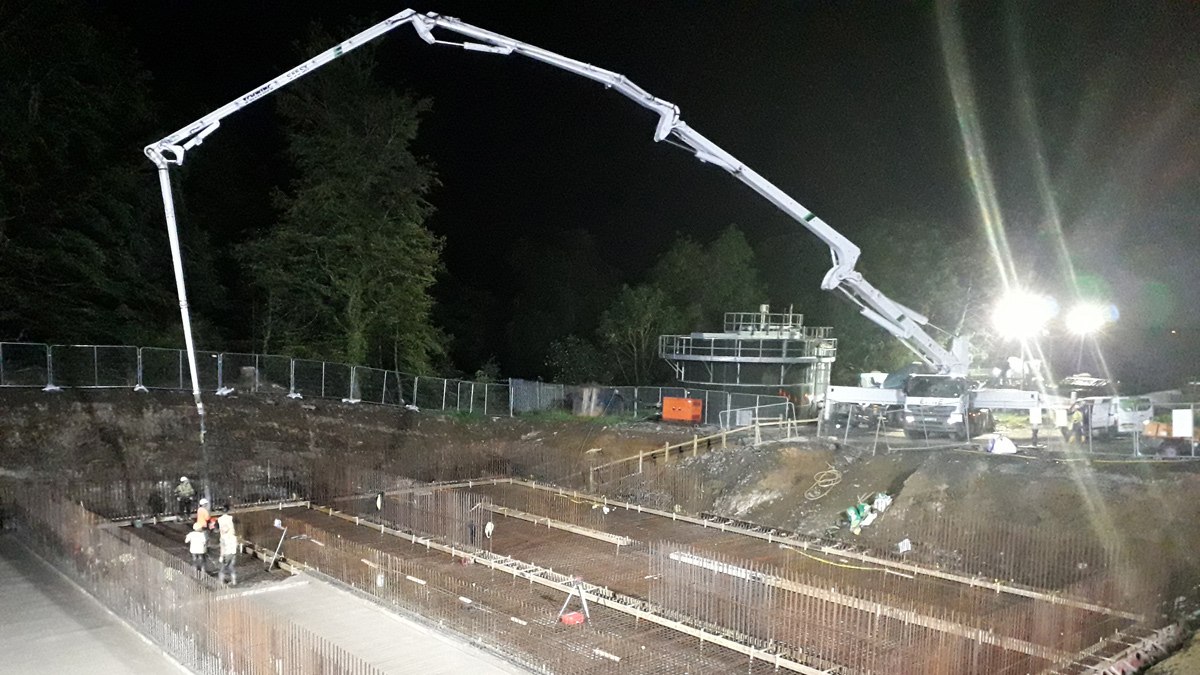
Night time concrete pour – Courtesy of GEDA Construction
During the construction process, WSI were tasked with designing and building a new main works MCC, to not only operate the Phase 1 and existing assets, but also any future assets installed as part of Phase 2 construction. The new MCC was installed alongside the existing MCC panels. Any assets from the existing MCC that had to be retained, until the Phase 2 works was complete, were transferred across. This required meticulous planning, communications and numerous shutdowns of existing plant and equipment and recommissioning to facilitate transitioning across to the new MCC.
The biological seeding process for the new fine bubble diffuser aeration (FBDA) activated sludge lanes required technical input to manage the existing biological treatment process, whilst bringing the new biological treatment process online. With the 3 (No.) new FBDA ASP lanes providing a large volume of treatment capacity, it was not feasible to solely rely on seeded sludge to bring the new lanes online and instead, WSI transferred across the contents of the existing activated sludge basins in a phased manner to maintain treatment capacity. A detailed commissioning plan was developed to accurately plan the transition from the existing 4 (No.) surface aerator tanks to the 3 (No.) new FBDA ASP lanes whilst maintaining effective treatment to meet the required discharge consent. An on-site sampling regime was undertaken to manage the required flow split to both the existing treatment process and the new process. This was adjusted on a daily basis according to the site conditions and available treatment capacity of the new lanes e.g. working volume and increasing mixed liquor concentrations.
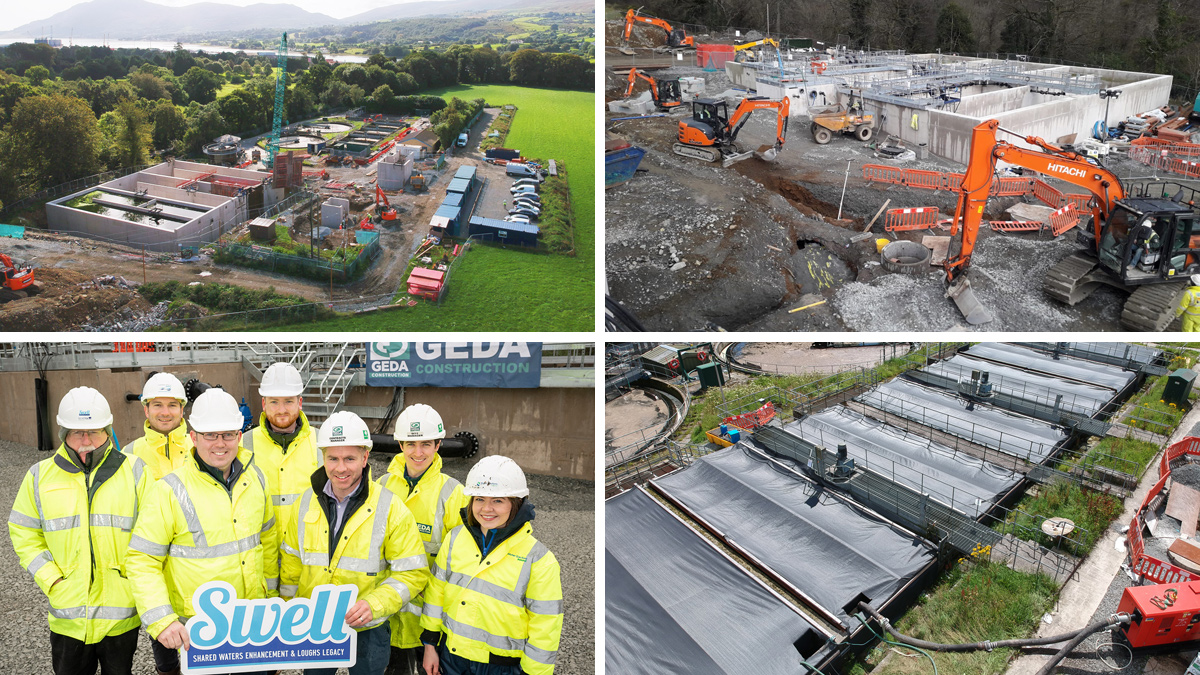
(top left) aerial view of site – September 2019, (top right) Construction progress – January 2020, (bottom left) The Warrenpoint project team and (bottom right) Old aeration tanks covered for COVID-19 – Courtesy of NI Water SWELL
An unprecedented and ongoing challenge experienced by the construction industry, and one which was realised to a large extent for the SWELL projects, is COVID-19. During the build and commissioning process of Warrenpoint WwTW, a temporary suspension of work was imposed on the construction sites.
Fortunately, the main elements of plant and equipment for the Phase 1 project had been procured so risks associated with the supply chain that may not have survived the economic impact of the pandemic were removed, and delays associated with supply chains were limited. The main delays attributed to the project programmes were as a result of site demobilisation and remobilisation. Once sites reopened, further delays were experienced due to increased health and safety measures, which limited the number of workers working in close proximity on sites in order to try and protect key workers from contracting the virus. The initial suspension of works and drop in productivity when sites reopened meant that the original programmes were extended.
A safe system of work was put in place on site where lunch hours were staggered, limited numbers of workers were permitted within dedicated zones of work, full PPE relating to COVID-19 was enforced at all times. A dedicated COVID-19 officer was appointed and regular toolbox talks were delivered to train and educate those working on site of the dangers of COVID-19. Best practice measures were taken to reduce risks of transmission, e.g. installation of polythene membrane on the top of the existing surface aerator tanks to reduce exposure to aerosols created by the process.
Regardless of all the challenges, thanks to the collaborative work from all the teams involved at ECI stage and during construction, the project was delivered on time for post-improvement evaluation and within budget (only 3% increase to the tendered value).
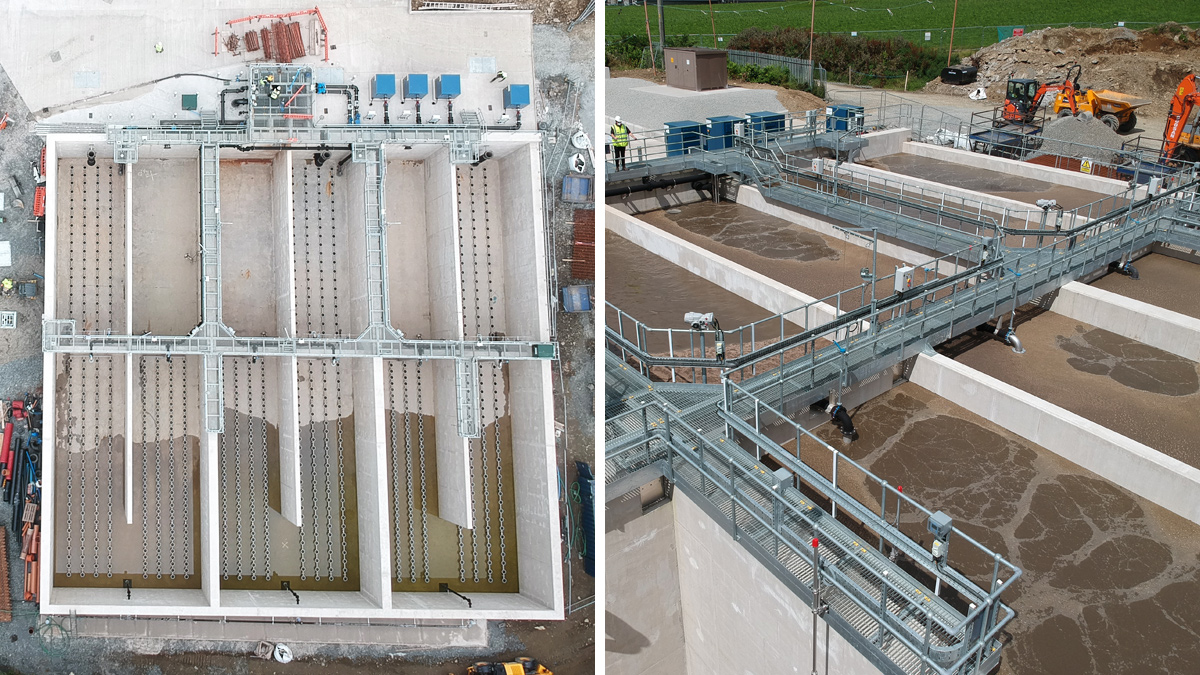
(left) Cleaned out ASP (July 2020) and (right) ASP with lanes filled – Courtesy of NI Water SWELL
Outcomes
The new activated sludge plant was commissioned in September 2020. Commending the team on reaching this key milestone, despite the COVID-19 challenges, NI Water SWELL Project Manager, Tomasz Piadlo said:
“The new activated sludge plant at Warrenpoint is a substantial structure built to replace the smaller 40-year-old tanks on the site. With twice the volume of an Olympic-size swimming pool, the new ASP is equipped with three aeration lanes, each with over 300 diffusers, which distribute oxygen into the tanks to break down the bacteria in the wastewater.
“This process forms part of the secondary treatment stage at the new WwTW. Before the wastewater arrives at the ASP it goes through a preliminary treatment phase, where a new balance tank helps control the flow and a new inlet works ensures the wastewater is screened before it passes to the new ASP.”
The full SWELL Phase 1 upgrade at Warrenpoint WwTW, which can accommodate a population of 21,000PE, was successfully commissioned and handed over to NI Water in December 2020.
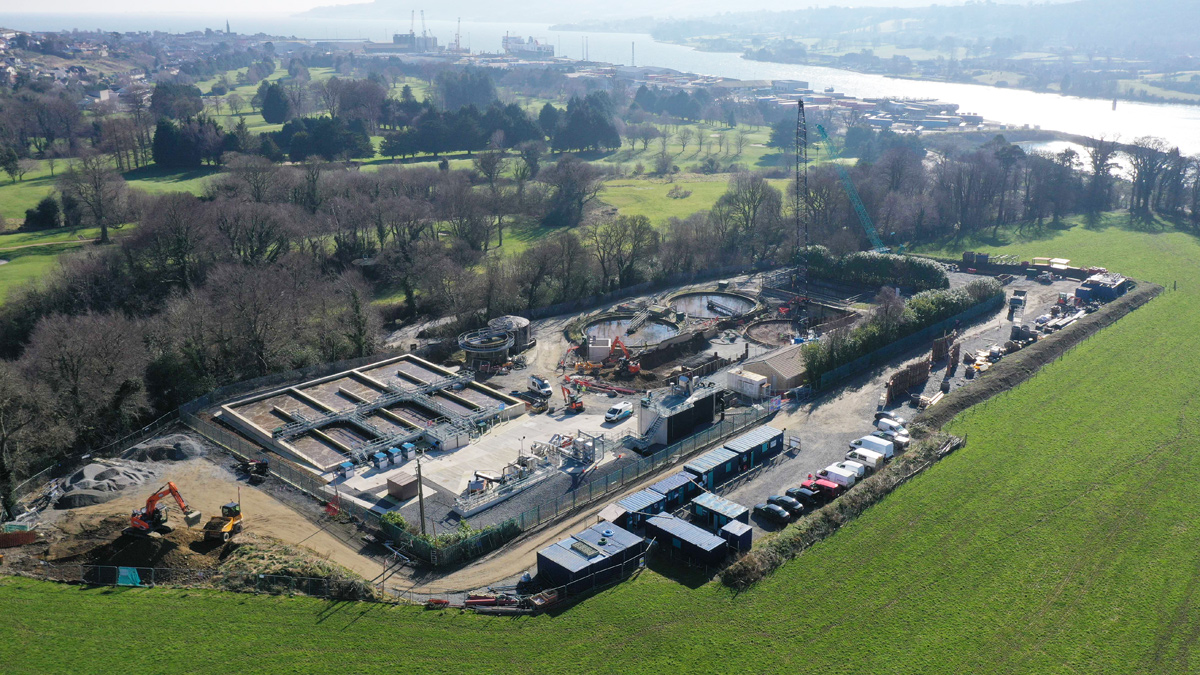
Warrenpoint WwTW after SWELL upgrade – Courtesy of NI Water SWELL
The benefits of the new infrastructure were realised almost immediately, with early indications showing that the final effluent to Carlingford Lough is of a much higher quality as a result of the significant investment made under EU’s INTERREG VA Programme, managed by the Special EU Programmes Body. The objectives of the Warrenpoint upgrade that were met were:
- Improved inlet flow management and effective use of storm storage facilities during periods of heavy/prolonged rainfall.
- Alleviated pollution resulting from unsatisfactory loss of biological loading to Carlingford Lough.
- Improved water quality within Carlingford Lough through enhancement of the treated effluent quality.
- Provided a solution that offers flexibility and reliability and be capable of serving the catchment needs over a 25-year project horizon.
- Provided a works that complies with all relevant water industry specifications and NI Water asset design standards.
- Provided additional treatment capacity thereby facilitating housing and trade growth within the area.











